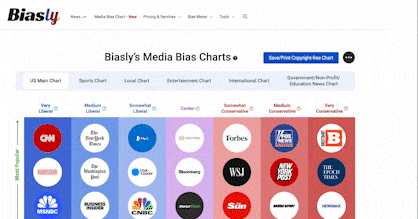 CalMatters Article Rating
CalMatters Article RatingThey live in California’s Republican districts. They feel betrayed by looming health care cuts
- Bias Rating
- Reliability
90% ReliableExcellent
- Policy Leaning
10% Center
- Politician Portrayal
-25% Negative
Continue For Free
Create your free account to see the in-depth bias analytics and more.
By creating an account, you agree to our Terms and Privacy Policy, and subscribe to email updates.
Bias Score Analysis
The A.I. bias rating includes policy and politician portrayal leanings based on the author’s tone found in the article using machine learning. Bias scores are on a scale of -100% to 100% with higher negative scores being more liberal and higher positive scores being more conservative, and 0% being neutral.
Sentiments
N/A
- Liberal
- Conservative
| Sentence | Sentiment | Bias |
|---|---|---|
Unlock this feature by upgrading to the Pro plan. | ||
Reliability Score Analysis
Policy Leaning Analysis
Politician Portrayal Analysis
Bias Meter
Extremely
Liberal
Very
Liberal
Moderately
Liberal
Somewhat Liberal
Center
Somewhat Conservative
Moderately
Conservative
Very
Conservative
Extremely
Conservative
-100%
Liberal
100%
Conservative

Contributing sentiments towards policy:
81% : Rep. David Valadao in the San Joaquin Valley represents the greatest share of Medicaid enrollees in the state at 67%.61% : Morales enrolled in Medicaid as a child and continues the health insurance program.
56% : Natalie Padilla signed up for Medicaid 17 years ago.
55% : The number of people with Medicaid in California has increased 31% since 2014 when the Affordable Care Act allowed states to enroll people who made slightly more than the federal poverty threshold.
55% : Today, the state spends $161 billion on Medicaid, the majority of which comes from the federal government.
54% : Medicaid provides health insurance for disabled and low-income people.
53% : Elijah is a lively boy, Rios said, but his disability means he’ll likely need Medicaid for his entire life.
52% : “I’ve heard from countless constituents who tell me the only way they can afford health care is through programs like Medicaid,” Valadao said that day, indicating he could vote differently later in the year on a final proposal.
52% : In her district, which covers portions of Orange County and the Inland Empire, 21% of people use Medicaid.
51% : About an hour north of Bakersfield, Rodolfo Morales-Ayon, a 21-year-old community college student, relies on Medicaid today.
51% : Padilla grew up in the district and said multiple family members, including cousins and her 84-year-old grandmother, have Medicaid.
50% : Medicare insures seniors over 65.
50% : Josephine Rios’ 7-year-old grandson, Elijah, needs Medicaid to manage his cerebral palsy, the certified nursing assistant from Orange County said.
48% : Farther south in Orange County, Josephine Rios’ 7-year-old grandson has cerebral palsy and needs Medicaid to pay for his medication and specialized wheelchair, which cost $22,000.
48% : In some areas of the state, Medicaid is the only reason why health centers and hospitals can piece together enough revenue to stay open, Silva said.
47% : Her family who rely on Medicaid have low-paying or part time jobs that don’t offer health insurance.
47% : In Orange County, Rios, a certified nursing assistant for Kaiser Permanente, voted and rallied for Republican Rep. Young Kim, but these days she’s consumed by the thought of what will happen if Medicaid is cut.
46% : Republicans have focused talks on rooting out “waste” and “fraud” in federal programs, but early proposals appear to aim at the fundamental payment structure of Medicaid.
46% : Morales-Ayon had Medicaid as a child because his parents’ jobs didn’t provide insurance.
44% : Six years ago, his vote to eliminate the Affordable Care Act likely cost his reelection for a term.
43% : The Senate voted on a narrower budget bill that is less likely to hit Medicaid, but the chamber will have to come to an agreement with the House later in the year.
41% : Other Republicans represent swing districts where voting against Medicaid could be risky politically.
40% : Although the details will take months to iron out, the nonpartisan Congressional Budget Office released a report last week indicating that it was impossible for House Republicans to meet their goal of eliminating $880 billion in spending over the next 10 years from the committee that oversees Medicaid and Medicare without cutting from either of the social safety net programs.
40% : “Medicare, Medicaid — none of that stuff is going to be touched,” Trump said in a February interview with Sean Hannity on Fox News.
39% : The statement made no mention of Medicaid.
36% : But Republican lawmakers want a deal that would offset the cost of extending Trump’s first-term tax cuts that are set to expire at the end of this year, and Medicaid represents the largest share of federal funding to states.
25% : Some of the state’s most conservative areas benefit disproportionately from Medicaid, including Rep. Jay Obernolte’s district in San Bernardino County’s high desert and Rep. Doug LaMalfa’s district in the far northern counties, where 48% and 43% of the population have Medicaid respectively.
23% : In a statement on the House floor following the initial budget vote, Valadao said extending Trump’s 2017 tax cuts would make a real difference for “working families, farmers, and small business owners” but acknowledged that many of his constituents need Medicaid.
*Our bias meter rating uses data science including sentiment analysis, machine learning and our proprietary algorithm for determining biases in news articles. Bias scores are on a scale of -100% to 100% with higher negative scores being more liberal and higher positive scores being more conservative, and 0% being neutral. The rating is an independent analysis and is not affiliated nor sponsored by the news source or any other organization.






















